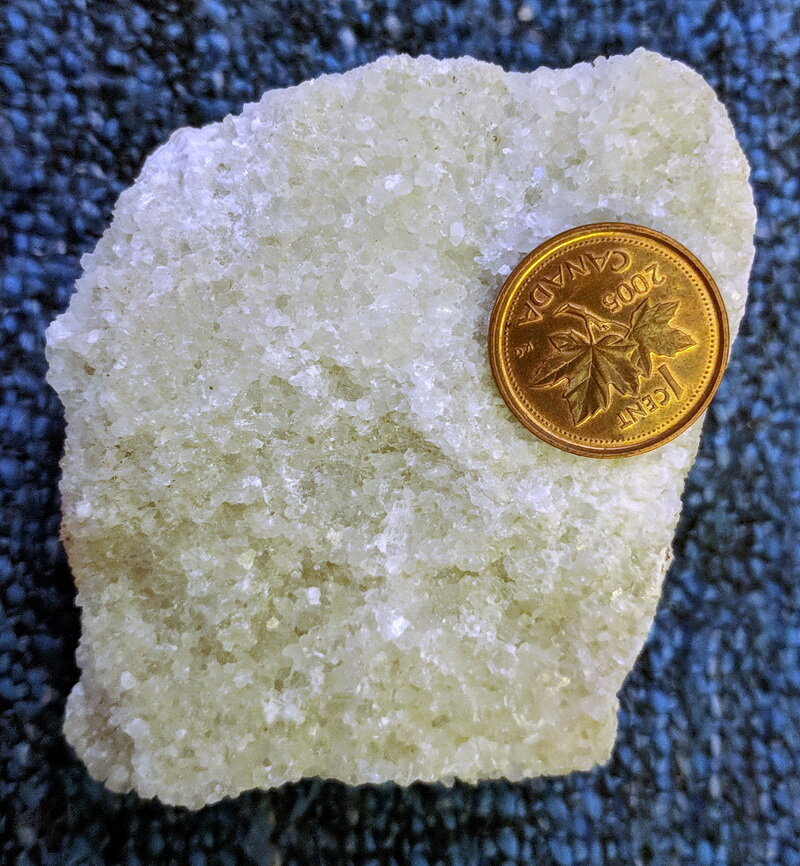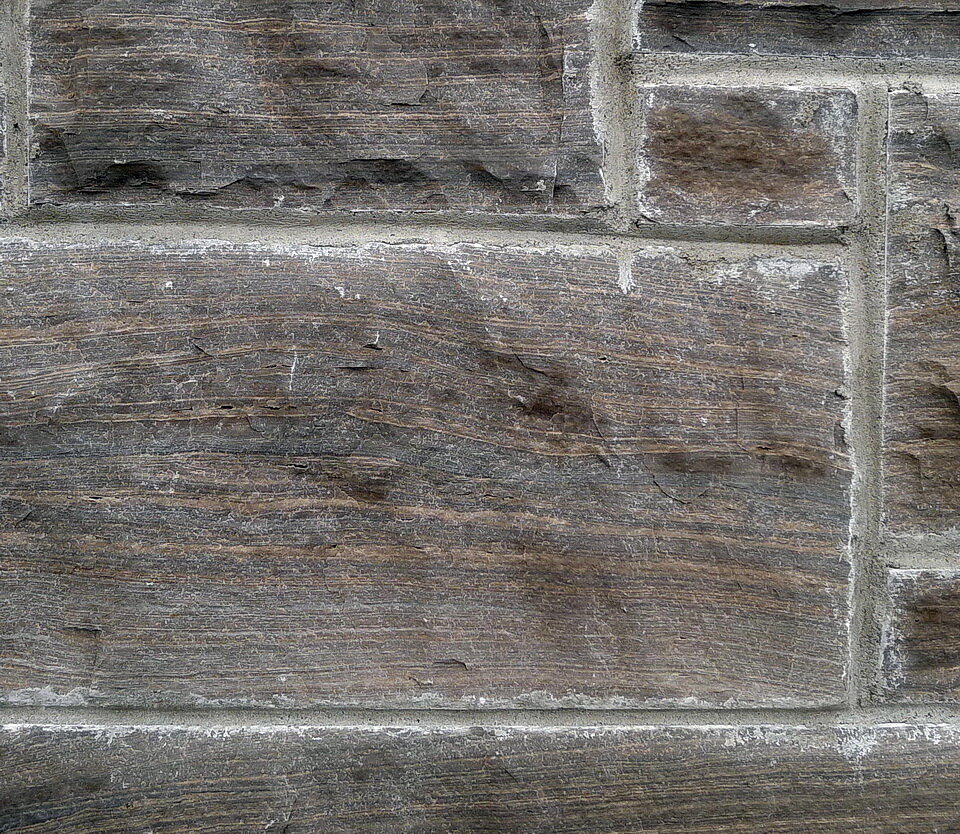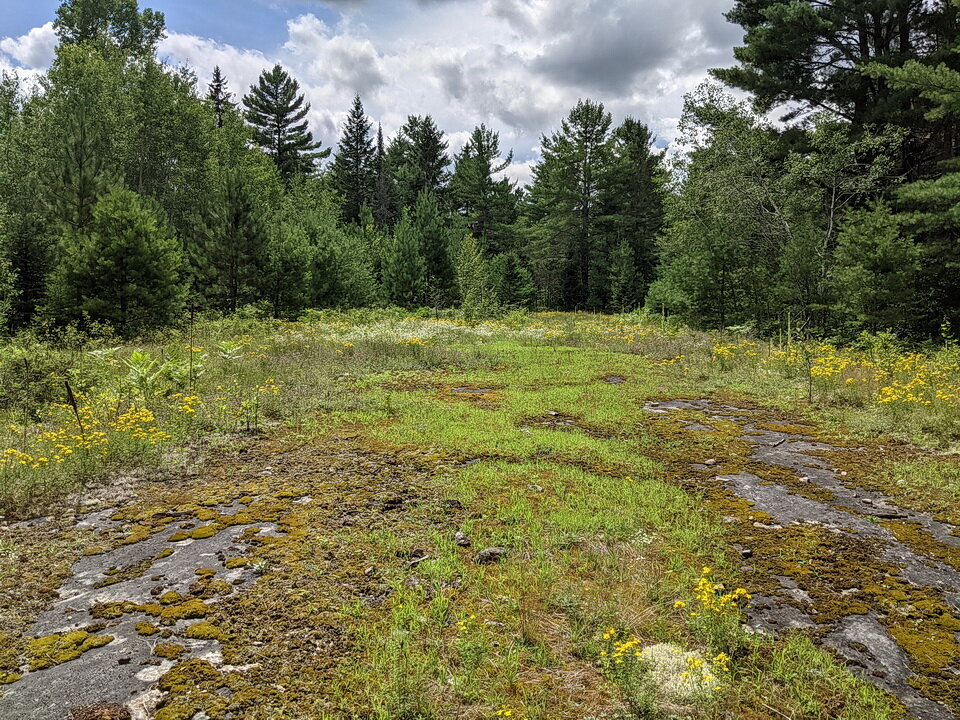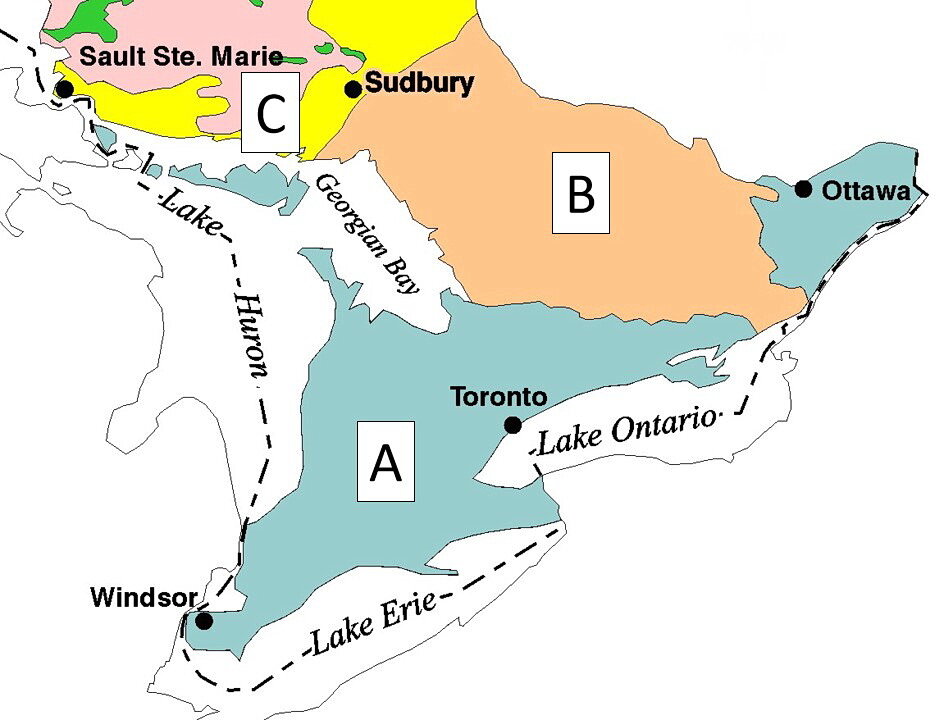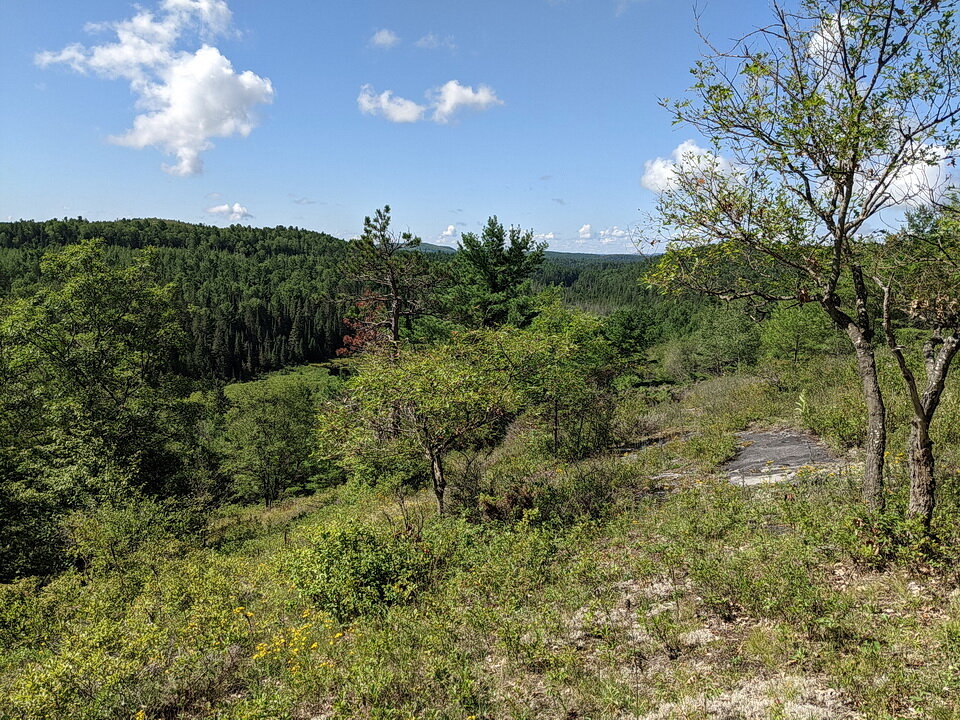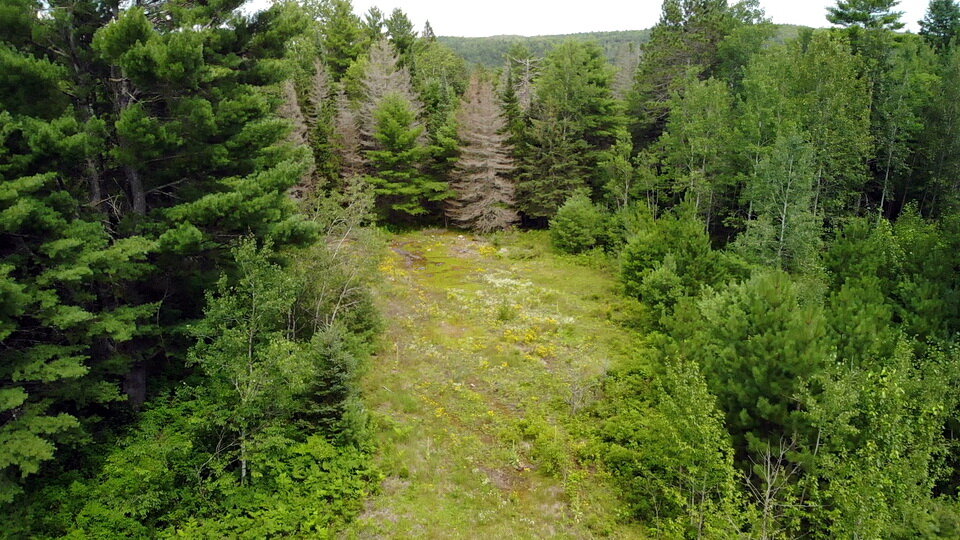Habitat (Ontario): Marble Barrens
In this note, I describe some of the geological and geochemical characteristics of an habitat called marble barrens. The marble barrens I looked at are located on Centennial Lake, just south west of Black Donald Lake, and in, and adjacent to, the Centennial Lake Provincial Nature Reserve, west of Ottawa, Canada (Photo 1).
Photo 1: The red triangles indicate the general location of the marble barrens that I examined. The location of the Centennial Lake Provincial Nature Reserve is illustrative only. Please refer to the official Ontario Parks website for the location details of Centennial Lake Provincial Nature Reserve. There are likely several other areas of exposed marble barrens, based on analysis of the Google Earth satellite imagery.
What Is A Barrens?
A barren land area where plant growth may be sparse, stunted, and/or contain limited biodiversity is called a barrens. Environmental conditions such as toxic or infertile soil, acidic or alkaline conditions, well drained soils, high winds, coastal salt-spray, and climatic conditions are some factors that contribute to development of a barrens and hence to poor plant growth and development. Barrens are generally distinguished by the specific soils, or rock substrates, on which they occur. Soil depth on a typical barrens vary widely and abruptly. Therefore, water-retention capacity also varies widely over short distances.
While this note focuses on rock barrens underlain by marble, other types of barrens exist globally, including scrub oak-pitch pine, ridgetop acidic, serpentine, shale, and mesic till barrens (e.g., Pennsylvania), pine barrens (e.g., Atlantic coastal pine barrens), and Oak barrens. Also, Canadian Shield mixed rock assemblages can create barrens in areas where the geological history exposes and isolates acidic or alkaline rock at the surface (e.g., Carp Hills barrens).
The distinction between these types of barrens strongly implicates the immediate geology as an important factor influencing the type of barrens.
Ecological Significance of Barrens
Barrens are typically characterized by biological specialization and diversity, which makes barrens invaluable to wildlife at local and landscape scales. Variation of the physical and chemical characteristics of a barrens habitat create a mosaic pattern of vegetation and corresponding mosaic of animal, insect, amphibian, reptile, and bird distributions.
Botanical Interest
In general, rock barrens are an interesting botanical habitat. The type of vegetation growing on barrens is called called barren vegetation. Barren vegetation can be categorized by climate, geology, including the physical and chemistry characteristics of the substrate, and geographic location. The barrens can be a harsh place for plants to grow. For example, the geochemical characteristics of a barrens determines the supply of mineral substances. Plant metabolism must adjust to the mineral substances present and their abundances. Mineral composition of the soil, acidity (e.g., pH), alkalinity, and availability of ions are principally dependent on the nature of the unconsolidated soil and the underlying rock - that is, local geology. Therefore, barrens vegetation is generally characterized by species that are adapted to the specific conditions of a barrens. Example, calcicolous plants are adapted to grow on calcareous barren substrate, like limestone, dolomite and marble. Conversely, calcifuge plants prefer, or are adapted, to grow only on siliceous and sandy, calcium-deficient soils.
In summary, the geology and geochemistry of the barrens substrate can strongly influence the presence of specialized plants that tolerate the harsh conditions.
What Are Marble Barrens?
My focus in this note are marble barrens. Marble barrens are underlain or dominated by a rock substrate consisting of marble. Geologically, marble is a metamorphic rock (Photo 2). The marble is derived from the sedimentary rock called limestone (Photo 3). The limestone formed from limy muds and marine animal remains that accumulated on the bottom of a warm, tropical sea. Through the process of burial and heating called diagenesis, the limy muds were progressively transformed into the rock limestone. With further burial and heating, known as metamorphism, the limestone was transformed into marble.
Photo 2: Marble is a white-coloured, coarsely crystalline rock (grain size is obvious to the eye) that is created by heating of limestone under higher pressure, deep below the surface of the Earth. Photo by Andy Fyon, 2017.
Photo 3: Limestone that is used as decorative building facing. Geologists call this the Eramosa limestone and it occurs in southern Ontario. When buried deeply below the Earth’s surface, the limestone is heated and squeezed and transformed into marble. Photo by Andy Fyon, December 22, 2015.
Despite having been formed by metamorphism deep below the Earth’s surface, marble can be exposed on the Earth’s surface as the result of great geological processes that lifted the marble from deep in the Earth to the Earth’s surface. Once exposed on the Earth’s surface, geological processes like glaciation, freezing and thawing, and weathering shape and affect the exposed marble. Those processes contribute to the formation of the marble barrens habitat by virtue of exposing the marble rock (Photo 4).
Soil cover on top of the marble rock is thin to non-existent. Areas of bare marble rock are exposed on surface. Areas also exist between the bare rock exposures where soil is shallow, often filling bowls or valleys between the bare rock knolls. Together, the areas of exposed, bare marble and areas of shallow soil cover on top of marble rock constitute the marble barrens (Photo 4).
Photo 4: An example of the marble barrens that occurs within Centennial Lake Provincial Nature Reserve, Ontario. Four zones are visible in this photo. Zone 1: the dark- to black-coloured areas are the discoloured surfaces of exposed marble rock. That marble rock is not covered by any soil. Zone 2: where thin soil occurs, such as along the centre axis of the exposure, the marble supports sparsely developed vegetation, such as mosses, lichens, and specialized grasses (e.g., Philadelphia Panic Grass (Panicum philadelphicum). Zone 3: a deeper soil apron occurs around the outer perimeter of the marble barrens and supports ferns and other vascular plants before abruptly transitioning into the mixed forest. Zone 4: mixed forest. Photo composed by Andy Fyon, July 28. 2021.
Surface Colour of Marble
Once on the Earth’s surface, the exposed marble surface may take on a dark or black colour, yet the inside of the marble rock remains brilliant white in colour (Photo 5). The black surface colour is generally attributed to the presence and action of algae, bacteria, dirt or soot, fungus.
Photo 5: The sunglasses sit on the edge between two blocks of marble. The black-coloured marble surface is likely the result of algae, bacteria or fungus, which changed the normally white marble into a black-coloured surface. The white marble block shows the fresh surface of marble that has not been discoloured by the actions of algae, bacteria or fungus. Photo composed in Centennial Lake Provincial Nature Reserve, Ontario, by Andy Fyon, July 28, 2021.
Marble Sculptures
You might be familiar with some special sculptures carved from white marble, like David by Michelangelo. Although marble is a rock, it is soft enough to carve.
Centennial Lake and Black Donald Lake Area of Interest
In eastern Ontario, areas of barren vegetation occur on marble barrens west of Ottawa, in the Centennial Lake and Black Donald Lake area (Photo 1). These barrens are developed on 1 billion-year-old marble rock within the younger, southern part of the Canadian Shield (Area B in Photo 6). Geologically, the area of marble barrens occurs within the geological Grenville Province (Area B in Photo 6).
Photo 6: Simplified bedrock geology of southern Ontario. Zone A: youngest rocks of Ontario that are assigned to the Paleozoic era and range in age from 540 to 360 million years old. Zone B: Grenville Province - includes rocks that range in age from about 2 billion to 1 billion years old. These rocks are part of the larger Canadian Shield. Zone C: Superior Province (pink and green on map) and Southern Province (yellow on map), both of which consist of rocks that are older than 2 billion years in age.
The areas where I looked at the marble barrens are located in the southwest part of Centennial Lake Provincial Nature Reserve, west of Tipperary Hunt Club Road, west of Black Donald Creek, an island in Centennial Lake, and a small roadside area by the Mountain Chutes Hydro electric Station (Photo 1).
Geology of the Black Donald and Centennial Lakes Area
The detailed bedrock geology of the area is a critical factor contributing to the establishment of the marble barrens (Photo 7). More detailed information about the bedrock geology of the area is illustrated on the northeast corner of Preliminary Map #3807 and Preliminary Map #3438, both published by the Ontario Geological Survey. Alternatively, you can use the bedrock geology theme presented in OGS Earth to create a simplified bedrock geology of the area, which I present here as Photo 7.
Photo 7: The red triangles illustrate the approximate location of the marble barrens I looked at in this area. Explanation of the bedrock geology of the Black Donald and Centennial lakes area: Blue = marble; Yellow = Clastic metasedimentary rocks, which include conglomerate, wacke, quartz arenite, arkose, limestone, siltstone, chert, minor iron formation, minor metavolcanic rocks; Pink = Felsic plutonic rock, which includes granodiorite, tonalite, monzogranite, syenogranite and derived gneisses and migmatites. Dark green = Mafic to ultramafic plutonic rocks, which includes diorite, gabbro, peridotite, pyroxenite, anorthosite, derived metamorphic rocks. Light green = Mafic to felsic metavolcanic rocks, which includes flows, tuffs, breccias, minor iron formation, minor metasedimentary rocks, reworked pyroclastic units, amphibolite. While this is a bit of a mouthfull for the non-geologist, the key rock type is the marble, which is coloured blue on this bedrock geology map. Map created using the bedrock geology theme in OGSEarth (https://www.mndm.gov.on.ca/en/mines-and-minerals/applications/ogsearth/bedrock-geology).
Although there are several varieties of rock in the area, the key rock is marble, shown in blue on the bedrock geology map (Photo 7). It goes without saying, to have marble barrens you need marble substrate rock that is exposed on the land surface or very close to the land surface.
The limestone that was transformed into the marble was born of limy muds that accumulated on the floor of a shallow, when the land we call Ontario was located close to the equator and covered by a tropical ocean. Progressive burial and heating in a marine basin transformed the limy mud into limestone. Geologists conclude that the limy mud accumulated about 1 billion years ago! In response to cataclysmic geological processes, the limestone was then deeply buried below the Earth’s surface where it was cooked, or metamorphosed as geologists say, and transformed into marble. Over millions of years, other geological processes lifted the marble to the Earth’s surface. Once on the land surface, glaciation and weathering created the rolling land surface we see today and created the foundation for the marble barrens that we walk on today.
Some Physical and Geochemical Characteristics of Marble
Marble has some important physical and geochemical characteristics that influence plant growth:
marble is made almost exclusively of the mineral calcite, which is composed of calcium carbonate;
the mineral calcite is rich in the element calcium, so the environment tends to be rich in the element calcium;
individual crystals of calcite in the marble have a large grain size of up to 1 cm across;
individual calcite crystals have been plucked out of the rock surface by freezing and thawing and accumulate as a collection of loose crystals (Photo 8);
the exposed marble surface appears to be “tight” without many cracks or fractures, which discourages moisture retention;
given the predominance of the mineral calcite, the geochemical composition of the marble is virtually devoid of essential plant nutrients, like phosphorous, nitrogen, and potassium;
the geochemical composition of the marble creates an alkaline, limy environment;
physically, the marble forms rounded hills with south- and west-facing slopes that become hot and dry during the summer (Photo 9).
Photo 8: Marble that is being disaggregated into pieces and individual calcite crystals. The individual crystals have a grain size up to 1 cm across. Image composed in Centennial Lake Provincial Nature Reserve, Ontario. Photo composed by Andy Fyon, July 21, 2021.
Photo 9: A typical marble barrens, looking south west. Black Donald Creek occupies the valley wetland. Grey surface-coloured marble is exposed in places. Vegetated thin soil covers much of the gently sloping marble barrens. The southerly sloping area becomes hot during the summer. Photo composed in Centennial Lake Provincial Nature Reserve, Ontario. Photo by Andy Fyon, July 21, 2021.
Together, these physical and geochemical characteristics of the marble make this marble barrens a challenging environment for vegetation to grow.
Preliminary Vegetation Observations: Marble Barrens in the Black Donald and Centennial Lakes Area
I provide only some simplistic observations in this note because the types of vegetation will be the focus of a future note.
The marble barrens are characterized by sparse vegetation, including sparse tree cover, and patches of exposed marble bedrock on low, rolling hills that were created by scraping by glaciers during the last ice age (Photo 10).
Photo 10: Typical marble barrens located west and south of the Tipperary Hunt Club cabin, located along the Tipperary Hunt Club trail, southwest of Black Donald Creek. Marble rock is partly exposed in this clearing. Shallow soil supports various types of plants. Mixed forest trees exist where the soil is deeper. Image composed by Andy Fyon, July 28, 2021.
Yet, some specialized native plants, adapted to grow on the challenging calcareous marble barrens, grow on the marble barrens, including: a) Philadelphia panicgrass (Panicum philadelphicum); b) rock sandwort (Sabulina michauxii); c) hairy beardtongue (Penstemon hirsutus); and d) Rough False Pennyroyal (Hedeoma hispida). In addition, the marble barrens are home to several introduced plant species that thrive on the open grasslands and thin soil on the marble rock, including: a) common viper’s bugloss (Echium vulgare); b) common St. John’s-wort (Hypericum perforatum); c) thyme-leaved sandwort (Arenaria serpyllifolia); and d) wild basil (Clinopodium vulgare).
Marble Barrens and Alvar
Marble barrens share some important geochemical features with alvars. This is not surprising because marble is created from limestone that was buried and cooked deep in the Earth by a geological process called metamorphism. Both alvars and marble barrens are characterized by: a) calcium-rich, alkaline soil produced by the hydration weathering of limestone and marble, respectively; b) low concentrations of plant nutrients, like nitrogen, potassium and phosphorous; c) thin to absent soil cover; d) low moisture retention; and e) open, hot, sunbaked land. These characteristics make alvars, particularly alvar pavements, and marble barrens a challenging place for plants. So, it should not be surprising that the floristic communities of alvar and marble barrens have some similarities.
Summary
Marble barrens occur in the Black Donald Lake, Centennial Lake, and Centennial Lake Provincial Nature Reserve areas, west of Ottawa. The marble barrens occur in a geological region named the Grenville Province, which formed about 1 billion years ago. The low rolling marble hills and the marble rock were exposed on the land surface and shaped by geological processes, like scraping by glaciers during the last ice age. Marble barrens are a harsh place for plants to grow. Yet the distinctive marble chemistry and the physical conditions of the barrens are factors that encourage the growth of specialized plants adapted to grow in this habitat. This biological specialization and diversity helps make the barrens invaluable to wildlife at local and landscape scales.
Acknowledgement
I extend a big thanks to Wasyl Bakowsky, Community Ecologist, Natural Heritage Information Centre (Northern Development, Mines, Natural Resources and Forestry (NRF)). Wasyl alerted me to the presence of the marble barrens in this area, discussed some potential areas to investigate, and graciously provided several key plant identifications to “new-to-me” species.
Have A Question About This Note?
August 22/21; Sept 21/21.


